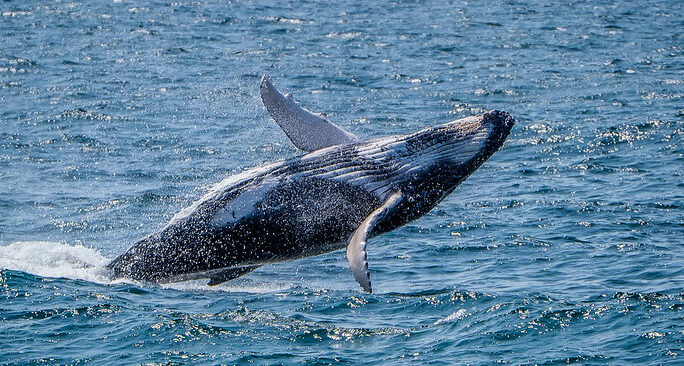Scientists have known for hundreds of years that whales were mammals (e.g., they give live birth, have sparse hair, produce milk for young). For most of that time, however, where they fit in the mammal family tree was a mystery, and very few fossils had been found that showed their transition from land to water. But an explosion of discovery and research over the past 30-40 years has solidified our understanding of how, when, and where whales evolved from their terrestrial mammal ancestors. In this lab you will:
- Watch a video describing the evolution of cetaceans and explore these transitions using 3D models. You will answer a set of questions about these transitions in the Whale Evolution Quiz.
- Watch a video overview of extant cetaceans and learn to identify local whales and dolphins from their external features, especially those you can see from above water while on a whale watching tour. You may then be quizzed on your ability to identify these local species.
There are five questions throughout this lab. A .docx file with those questions can be downloaded here:
Cetacean Evolution
Cetaceans can be categorized taxonomically into three major groups: Archaeocetes (ancient whales), Mysticeti (baleen whales), and Odontoceti (toothed whales). Arachaocetes have ancestral morphologies including external hind limbs, semiaquatic lifestyle (e.g., giving birth on land), and heterodont/diphyodont dentition. In contrast, extant whales have more telescoping (elongated) skulls and are completely aquatic (no external hind limbs). You’ll learn more about them in the next section.
In the latter half of the 20th century, increasingly powerful molecular tests confirmed that whales were most closely allied with artiodactyls, the even-toed ungulates like antelope, deer, pigs, and giraffe. By the 1990s, analyses were starting to place cetaceans (Order Cetacea) within Order Artiodactyla as a sister taxon to hippopotamuses. This meant Cetacea was no longer a valid order (you can’t have an order within an order!); Artiodactyla became Order Cetartiodactyla, whales and hippopotamuses were placed into Suborder Whippomorpha, and Order Cetacea was downgraded to Infraorder Cetacea (Mysticeti and Odontoceti are “parvorders”).

1. Looking at the phylogenetic tree in the figure, Arachaocetes is a group that includes all of the stray branches off of the tree before crown cetaceans evolved. What type of taxonomic group is this (hint: it ends in “–phyletic”)? What type of taxonomic groups are Mysticeti and Odontoceti?
In 2001, two publications reported on the morphology of whale astragalus bones (ankle bones), which have pulley-shaped grooves that improve flexion and are adaptations for high speed running; extant Cetaceans lack these bones entirely as they lack hindlimbs. They compared the astragalus bones of several Eocene archaocetes to those of extant terrestrial cetartiodactyls and other mammals. Artiodactyls have a double pulley shaped (grooved) astragalus allowing flexion both above and below the bone; most other mammals have a single pulley above the bone, but the base is flat. Compare the Pakicetus (an archaocete) astragalus to those of other extant mammals:

2. What does this discovery tell us about the evolution of cetaceans and what can cetacean fossils tell us that extant cetacean bones cannot?
Watch this video on whale evolution:
The earliest archaeocetes look fairly terrestrial, while the most recent look very similar to extant cetaceans. The earliest archaocete clade is Pakicetidae, which lived in Indo-Pakistan in the early to middle Eocene (47-53 Mya). They probably moved between terrestrial and freshwater environments, feeding on freshwater prey. They retain many features typical of early terrestrial artiodactyls (e.g., long limb bones, no telescoping of the cranium).
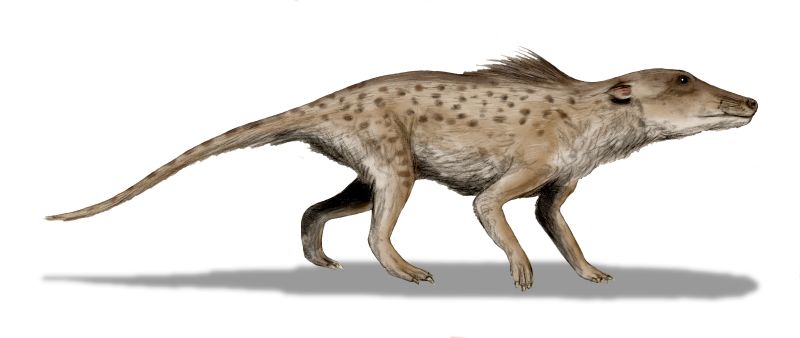
Intermediate between Pakicetids and later archaocetes, were the Ambulocetidae, which lived in the middle Eocene (46-48 Mya). Ambulocetus was probably an ambush predator with an alligator-like lifestyle, waiting for prey in shallow fresh water.

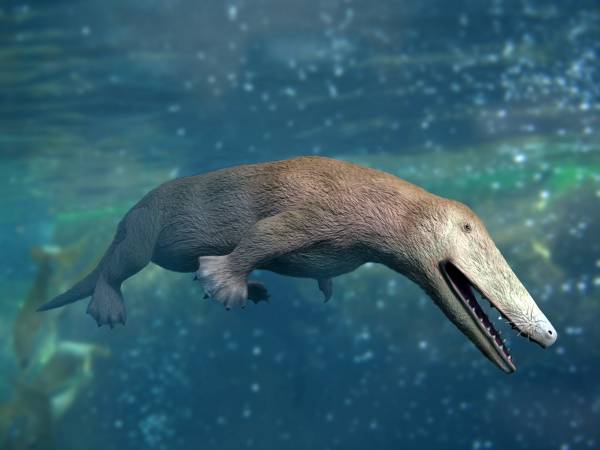
3. What changes in skull, limb, and body morphology do you see between Pakicetus and Ambulocetus?
Next up, Protocetidae first evolved in Indo-Pakistan but then diverged and spread rapidly through North Africa and North America from 37-48 Mya. They likely lived in marine environments in coastal areas foraging for fish and invertebrates. They still had a pelvis and well-developed hindlimbs, but the sacrum is weaker, suggesting limited ability to walk on land. The vertebrae are beginning to become more uniform, reflecting a more undulatory mode of swimming.
View this 3D model of the protocetid Maiacetus. Load the model and experiment with the controls. Leave this model open in a new browser tab for the next step.
The final archaeocete family we’ll explore is Basilosauridae. This group lived all over the world in the middle to late Eocene and were fully aquatic. They likely ate vertebrate and invertebrate prey and swam with both undulatory and oscillatory movements.
In a new browser tab, view the 3D model of the basilosaurid Dorudon. In these browser windows you can not only manipulate the model, but also take measurements. Move your mouse arrow over the tip of the tail of Maiacetus and press “S”. A dot should appear on the tail tip. Now move your arrow over the tip of the nose and press “E”. A second dot and a line connecting the dots appears and you should see a measurement in the upper left corner of the screen. Write this down. Now measure the length of the humerus bone in the same way. Do this for both Maiacetus and Dorudon.
4. Calculate the ratio of humerus:body length for each species and report them. What does the difference in this ratio suggest about the changing lifestyle of these groups? Describe THREE other pieces of morphological evidence of evolutionary change can you see in the models?
In addition to the shifts in morphology over the course of cetacean evolution, their lifestyles can also be studied using evidence from the fossil record. While most large bodied mammals require a source of freshwater and cannot desalinate large amounts of salt water, modern cetaceans have evolved this ability. Researchers have studied the drinking behaviors of extant and extinct cetaceans using stable oxygen isotopes. 16O and 18O are the two most common isotopes of oxygen and the ratios of the isotopes differ in fresh and salt water. Marine (oceanic) water has higher concentrations of 18O than does freshwater, and we can analyze the oxygen isotopes in the calcium phosphate of mammalian bones to determine what type of water they were drinking and, therefore, living in. Below is a figure showing the oxygen isotope ratios of modern marine and freshwater cetaceans along with those of extinct cetaceans.
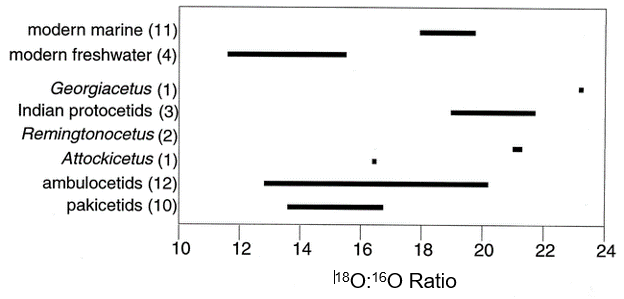
5. Interpret the figure above, and compare and contrast the types of bodies of water that early cetaceans (e.g., pakicetids, ambulocetids), later proto- and remingtonocetids, and most modern marine cetaceans live in.
Modern Whale Diversity and Identification
The modern extant cetaceans are divided into two groups: the Mysticeti (baleen whales) and Odontoceti (toothed whales). Baleen whales are named for their large plates of baleen (made of strands of keratin) and lack of true teeth, but baleen whales evolved from toothed mysticetes that eventually lost their true teeth and were either toothless or had/have baleen plates. Odontocetes have retained their teeth (although most now have simple homodont dentition) and have the ability to echolocate to detect prey, other whales, and underwater topographic features.
Watch the video below to learn about modern cetacean diversity:
Now that you have a handle on the types of extant cetaceans that live all over the world, it’s time to learn to identify some local whales. Many of you may have taken a whale watching trip at some point, and the waters off of Southern California have a number of baleen and toothed whales that you can spot with regularity. For the remainder of this lab, you will learn to identify the local species of whales using images from the surface of the water so that the next time you go on a whale watching trip, you will be able to identify what you see!
For each of the 10 species below examine the 3D model and associated photographs. You should, on your own, conduct Google Image searches of each species to find more images that show the same features and use these to study from. Learn to identify the distinguishing characteristics of each species. You may be quizzed using actual photographs (not the ones below) to demonstrate your ability to identify these species.
Odontoceti (dolphins and porpoises)
Short-beaked common dolphin (Delphinus delphis):
Most common year round with megapods in Summer. Look for a distinctive cream-colored patch on the side of the thorax with pale white underbelly; stout but distinctive beak, eye surrounded by pale color; 1.5-2m in length.


Bottlenose dolphin (Tursiops truncates):
Common year round. Uniformly gray with pale white underbelly; distinctive crease between the melon and short stubby beak; 2-4m in length.

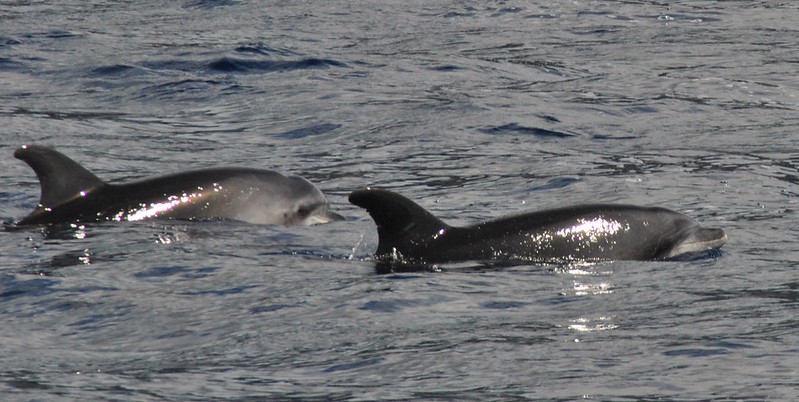
Risso’s dolphin (Grampus griseus):
Less common but mainly Summer and Fall. Lacks a beak; body pale gray and usually heavily scarred; 3m in length
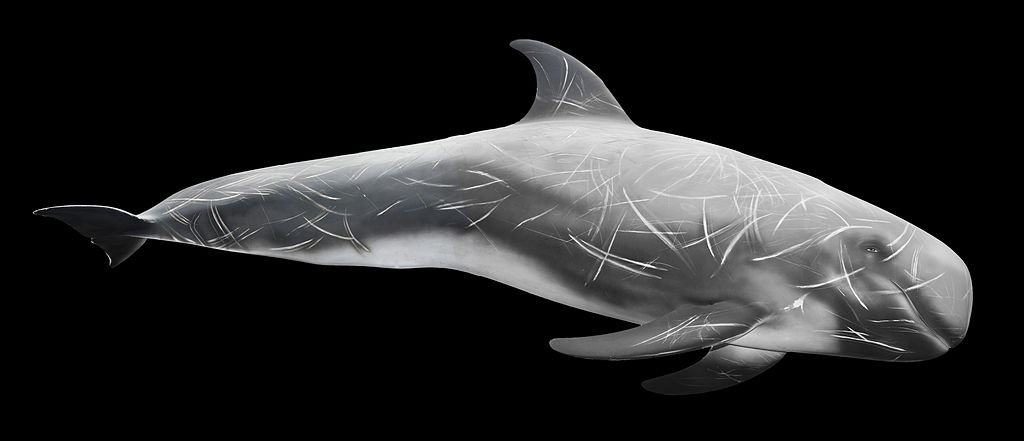


Harbor porpoise (Phocoena phocoena):
Less common and only north of Pt. Conception. Small body with gray dorsum fading to a white pale underbelly, very small triangular dorsal fin; 1.4-1.6m in length


Pacific White Sided Dolphin (Lagenorhynchus obliquidens):
Rare but mainly in Winter and Spring; Distinctive white patches on the side of the thorax and down the dorsal sides of the tail; bicolored dorsal fin that is more hooked than other dolphins; very short beak; 1.7-2.5m in length


Mysticeti (baleen whales):
Humpback whale (Megaptera novaeangliae):
Very common especially in Fall and Winter; Humped back with oddly stumpy dorsal fin; variable color on underside of fluke (black – white blotches – all white); long white pectoral fins; 14-17m in length



Gray whale (Eschrichtius robustus):
Very common but mainly in Winter and Spring. They make the longest migration of any mammal on earth when they travel from Alaska down the coast towards Mexico in December-February, and then back northward in March-May. No dorsal fin but small hump and many bumps down the posterior dorsum; Gray mottled skin and fluke; More pale top of the head; 12.8-16.8m in length



Minke whale (Balaenoptera acutorostrata):
Common Winter through Summer; Short body; curved sickle-shaped dorsal fin; white band across pectoral fins; varying degrees of white bands on flank; doesn’t usually expose tail fluke; 7.8-8.8m in length



Blue whale (Balaenoptera musculus):
Less common but mainly seen in Summer; Huge body (largest animal to ever live); mottled gray or blue-gray; very small dorsal fin far back on body; white underside to tail fluke; 23-24m in length



Fin whale (Balaenoptera physalus):
Less common but mainly seen in Spring; Distinctive boundary between dark gray dorsum pale underbelly at pectoral fins; strongish dorsal fin but not hooked; doesn’t usually expose tail fluke; 18-19m in length


Now that you have seen all of the local species, go back and study your images and learn the names of each species. If you are interested in purchasing a field guide to learn more about identifying the marine mammals of California (including pinnipeds), I recommend Allen et al. 2011 (information below).
References
- Allen, S.G., Mortenson, J., Webb, S., 2011. Field Guide to Marine Mammals of the Pacific Coast. University of California Press, Berkeley, 569pp.
- Marx, F.G., Lambert, O., Uhen, M.D., 2016. Cetacean Paleobiology. Wiley Blackwell, West Sussex, 319pp.
- Thewissen, J.G.M. & Bajpai, S. 2001. Whale Origins as a Poster Child for Macroevolution. Bioscience, 51(12), 1037-1049.
